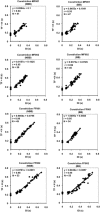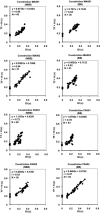Test of the movement expansion model: anticipatory vowel lip protrusion and constriction in French and English speakers
- PMID: 21303015
- PMCID: PMC3055290
- DOI: 10.1121/1.3518452
Test of the movement expansion model: anticipatory vowel lip protrusion and constriction in French and English speakers
Abstract
The modeling of anticipatory coarticulation has been the subject of longstanding debates for more than 40 yr. Empirical investigations in the articulatory domain have converged toward two extreme modeling approaches: a maximal anticipation behavior (Look-ahead model) or a fixed pattern (Time-locked model). However, empirical support for any of these models has been hardly conclusive, both within and across languages. The present study tested the temporal organization of vocalic anticipatory coarticulation of the rounding feature from [i] to [u] transitions for adult speakers of American English and Canadian French. Articulatory data were synchronously recorded using an Optotrak for lip protrusion and a dedicated Lip-Shape-Tracking-System for lip constriction. Results show that (i) protrusion is an inconsistent parameter for tracking anticipatory rounding gestures across individuals, more specifically in English; (ii) labial constriction (between-lip area) is a more reliable correlate, allowing for the description of vocalic rounding in both languages; (iii) when tested on the constriction component, speakers show a lawful anticipatory behavior expanding linearly as the intervocalic consonant interval increases from 0 to 5 consonants. The Movement Expansion Model from Abry and Lallouache [(1995a) Bul. de la Comm. Parlée 3, 85-99; (1995b) Proceedings of ICPHS 4, 152-155.] predicted such a regular behavior, i.e., a lawful variability with a speaker-specific expansion rate, which is not language-specific.
Figures








Similar articles
-
Anticipatory lip gestures: a validation of the Movement Expansion Model in congenitally blind speakers.J Acoust Soc Am. 2013 Apr;133(4):EL249-55. doi: 10.1121/1.4793436. J Acoust Soc Am. 2013. PMID: 23556687
-
Coarticulatory organization for lip rounding in Turkish and English.J Acoust Soc Am. 1990 Dec;88(6):2584-95. doi: 10.1121/1.400349. J Acoust Soc Am. 1990. PMID: 2283431
-
Temporal measures of anticipatory labial coarticulation for the vowel/u/: within- and cross-subject variability.J Acoust Soc Am. 1992 May;91(5):2911-25. doi: 10.1121/1.403778. J Acoust Soc Am. 1992. PMID: 1629484
-
The effects of antagonistic gestures on temporal and amplitude parameters of anticipatory labial coarticulation.J Speech Hear Res. 1981 Mar;24(1):16-24. doi: 10.1044/jshr.2401.16. J Speech Hear Res. 1981. PMID: 7253623
-
Evidence for the distinction between "consonantal-/r/" and "vocalic-/r/" in American English.Clin Linguist Phon. 2015;29(8-10):613-22. doi: 10.3109/02699206.2015.1047962. Clin Linguist Phon. 2015. PMID: 26172586 Review.
Cited by
-
The development of motor synergies in children: ultrasound and acoustic measurements.J Acoust Soc Am. 2013 Jan;133(1):444-52. doi: 10.1121/1.4763983. J Acoust Soc Am. 2013. PMID: 23297916 Free PMC article.
-
On the development of gestural organization: A cross-sectional study of vowel-to-vowel anticipatory coarticulation.PLoS One. 2018 Sep 14;13(9):e0203562. doi: 10.1371/journal.pone.0203562. eCollection 2018. PLoS One. 2018. PMID: 30216358 Free PMC article.
-
Asymmetric discrimination of nonspeech tonal analogues of vowels.J Exp Psychol Hum Percept Perform. 2019 Feb;45(2):285-300. doi: 10.1037/xhp0000603. Epub 2018 Dec 20. J Exp Psychol Hum Percept Perform. 2019. PMID: 30570319 Free PMC article.
-
Neurophysiological Correlates of Asymmetries in Vowel Perception: An English-French Cross-Linguistic Event-Related Potential Study.Front Hum Neurosci. 2021 Jun 3;15:607148. doi: 10.3389/fnhum.2021.607148. eCollection 2021. Front Hum Neurosci. 2021. PMID: 34149375 Free PMC article.
-
Upper Lip Horizontal Line: Characteristics of a Dynamic Facial Line.Int J Environ Res Public Health. 2020 Sep 13;17(18):6672. doi: 10.3390/ijerph17186672. Int J Environ Res Public Health. 2020. PMID: 32933221 Free PMC article.
References
-
- Abry, C., and Lallouache, T. (1995a). “Le MEM: Un modèle d’anticipation paramétrable par locuteur. Données sur l’arrondissement en français” (“MEM: A speaker parameterized anticipation model),” Bul. de la Comm. Parlée 3, 85–99.
-
- Abry, C., and Lallouache, T. M. (1995b). “Modeling lip constriction anticipatory behaviour for rounding in French with the MEM,” in Proceedings of ICPHS, 4, Stockholm, Sweden, pp. 152–155.
-
- Abry, C., Lallouache, M. T., and Cathiard, M. A. (1996). “How can coarticulation models account for speech sensitivity to audio-visual desynchronization?” in Speechreading by Humans and Machines, edited by Stork D. and Hennecke M. (NATO ASI Series F: Computer and Systems Sciences, Springer-Verlag, Berlin, Heidelberg, New York, London, Paris, Tokyo: ), Vol. 150, pp. 247–255.
Publication types
MeSH terms
Grants and funding
LinkOut - more resources
Full Text Sources

